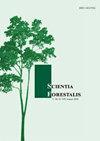Changes in leaf physiology for eucalyptus genotypes with increase in integral water stress and its consequence for initial growth in central Chile
IF 0.4
4区 农林科学
Q4 FORESTRY
引用次数: 0
Abstract
Limited information exists on how small changes in soil water affect the physiological responses of eucalyptus and their relationship with productivity. This experiment evaluated physiological traits during decreased soil water and compared them with growth and water stress integral (WSI) of 22 eucalyptus genotypes with 1.5 years old. The experiment was conducted in sandy soil with low water holding capacity in Chile. Selected genotypes were Eucalyptus globulus, E. nitens, and E. nitens × E. globulus hybrids (E. gloni). Seasonal predawn leaf water potential (Ψpd) was evaluated under well-irrigated conditions and after 40 days without irrigation. Subsequently, two sampling instances were considered for analysis, wellirrigated conditions M0 (470 days after planting) and 40 days without irrigation Mfinal (510 days after planting). During that period, we measured midday leaf water potential (Ψmd), leaf area index (LAI), diurnal changes in photosynthesis (An) and stomatal conductance (gs). The broad range of WSI among genotypes indicated contrasting levels of accumulated water stress during early development. In fact, E. globulus presented 30% more water stress than E. nitens, and genotypes with the highest WSI showed the lowest growth. Between M0 and Mfinal, there was a reduction in An and gs in the morning and midday with small changes in the afternoon, and consequently, values of the intrinsic water use efficiency (iWUE) increased. The Ψmd showed small changes and we observed a large LAI increment for all genotypes. Changes in iWUE were more pronounced for genotypes with lower WSI, which suggested that these genotypes with lower accumulated water stress were more sensitive to changes in soil water, such as E. gloni genotypes allowing them to maintain high productivity.智利中部桉树基因型叶片生理变化与整体水分胁迫的增加及其对初始生长的影响
关于土壤水分的微小变化如何影响桉树的生理反应及其与生产力的关系的信息有限。本试验评价了土壤水分减少时的生理性状,并与22个1.5年生桉树基因型的生长和水分胁迫积分(WSI)进行了比较。试验在智利低持水能力的沙质土壤中进行。选择的基因型为蓝桉、蓝桉和蓝桉×蓝桉杂交(绿桉)。在良好灌溉条件下和不灌溉40 d后评估季节黎明前叶片水势(Ψpd)。随后,考虑两个采样实例进行分析,即灌溉条件M0(种植后470天)和不灌溉40天Mfinal(种植后510天)。在此期间,我们测量了正午叶片水势(Ψmd)、叶面积指数(LAI)、光合作用(An)和气孔导度(gs)的日变化。不同基因型间WSI的广泛差异表明在发育早期积累水分胁迫的不同水平。事实上,黄颡鱼的水分胁迫比黄颡鱼高30%,且WSI最高的基因型生长最低。在M0和Mfinal之间,上午和中午的An和gs减少,下午变化较小,因此内在水分利用效率(iWUE)值增加。Ψmd的变化很小,我们观察到所有基因型的LAI都有很大的增加。WSI较低的基因型的iWUE变化更为明显,这表明积累水分胁迫较低的基因型对土壤水分变化更为敏感,如E. gloni基因型,使其能够保持较高的生产力。
本文章由计算机程序翻译,如有差异,请以英文原文为准。
求助全文
约1分钟内获得全文
求助全文
来源期刊

Scientia Forestalis
Agricultural and Biological Sciences-Forestry
CiteScore
1.00
自引率
0.00%
发文量
39
期刊介绍:
Scientia Forestalis is a scientific publication of the IPEF – Institute of Forest Research and Studies, founded in 1968, as a nonprofit institution, in agreement with the LCF – Department of Forest Sciences of the ESALQ – Luiz de Queiroz College of Agriculture of the USP – São Paulo University. Scientia Forestalis, affiliated to the ABEC – Brazilian Association of Scientific Publishers, publishes four issues per year of original papers related to the several fields of the Forest Sciences.
The Editorial Board is composed by the Editor, the Scientific Editors (evaluating the manuscript), and the Associated Editors (helping on the decision of acceptation or not of the manuscript, analyzed by the Peer-Reviewers.
 求助内容:
求助内容: 应助结果提醒方式:
应助结果提醒方式:


